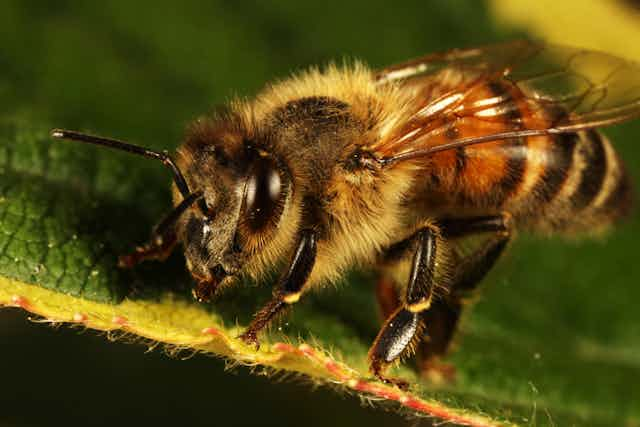In a honey bee colony, the queen bee rules while her daughter workers do nothing but work. So what happens when the queen dies? Are there worker riots, with the colony dissolving into a chaotic mess?
Surprisingly, no. In a study published in the journal Current Biology on Friday, my colleagues and I showed that while queenless bees do act a little more selfishly, they continue to work together to keep the colony going.
Like thousands of little Cinderellas not lucky enough to have fairy godmothers, daughter workers run the hive by raising their mother’s offspring, collecting and preparing food, cleaning, and defending their home from potential threats.
Behaving like the ultimate altruists, they forgo any opportunity to have offspring of their own despite being physically capable of producing sons.
However, monarchs don’t live forever. When the queen dies, the workers usually find an egg of suitable age and feed it royal jelly, resulting in a royal successor, allowing the colony to return to normalcy. But sometimes the workers do not succeed in raising a new queen, rendering the colony queenless.
Free from rule

Prior to our research, the common view among honey bee researchers was workers without a queen become “selfish” and cease working: stop foraging, feed from colony resources, and start laying eggs.
Inevitably, when the entire (up to 60,000-strong) worker population starts producing hungry [drones](http://en.wikipedia.org/wiki/Drone_(bee%29) (male bees) and consuming its resources without replenishing them, the colony begins to die of starvation: death by self-parasitism.
With no existing data supporting these claims, we decided we should test them.
To test whether queenless, reproductive workers are selfish, we removed the queens from several colonies in Australia and America, and prevented the workers from raising a new one.
Over a few weeks, the workers began to lay eggs. Once laying began, we captured bees returning to the hive after a foraging trip and marked them with paint to identify them as bees that had foraged. We then took samples of painted foragers and non-foragers and examined whether they were in a reproductive state.
Against the expectations of decades of bee research, we found both foragers and non-foragers had activated ovaries, indicating that queenless reproductive workers are not acting selfishly as they bring back food to the hive.
In fact, after watching and marking several bees in the act of laying an egg, we later observed them foraging.
By comparing them to random hive bees, we found that workers observed in the act of laying were more likely to forage than those who had not been observed laying - solidifying our evidence that reproductive workers are contributing to colony welfare.

Under predation
Surprised by our results, we ran another experiment asking if these queenless, reproductive workers would defend the hive attacking and stinging in response to a threat. Since they usually die when they sting, this is the ultimate sacrifice.
We created a black, feathered pseudo-predator and shook it over the colony frames, making the bees very angry - see the video below. The bees that attacked the “predator” got caught in the feathers and were immediately frozen for later dissection.
The attacking bees were compared with random non-attacking hive bees and we found no difference in ovary activation between the two groups, showing that even the reproductive bees are willing to defend the hive.
We also tested bees’ willingness to sting by subjecting them to mild electric shock and found the same result – ovary activation was unrelated to a worker’s propensity to sting.
We then compared the reproductive workers in queenless colonies to workers in colonies with queens.
In queen-led colonies, non-foragers are capable of feeding brood and maintaining the hive, while foragers cannot perform either of these tasks.
When in a queenless colony, we found both foragers and non-foragers can feed brood and have wax flakes for honeycomb building.
Altruism shines through
It turns out that reproductive queenless worker bees are not “selfish”. Not only do they lay eggs to produce sons, but they also forage, defend the hive, and can feed brood and build comb.

Freed from the queen, they get on with all of the things they need to do, while managing to behave altruistically to all – except, of course, potential predators.
Interestingly, this is how some other, less social bee species behave. They all defend a shared nest, but get on with their own reproduction, foraging and maintenance work.
So what does this research mean for the bees - and us?
Animal pollinators, including bees, are responsible for pollinating 35% of our global food crops. Honey bees are arguably the world’s most versatile pollinators as they successfully pollinate several different crop species, their colonies have relatively large foraging populations and they can be transported to where they are needed.
Because bees pollinate while they forage for pollen and nectar, investigating how colony state impacts foraging behaviour is key to understanding how to best protect the honey bee and use them efficiently to help feed the world’s growing population.
There is still work to be done here, but don’t worry, we’re on it.

